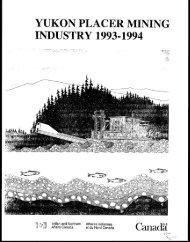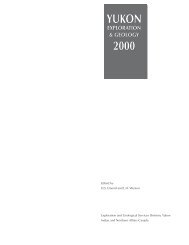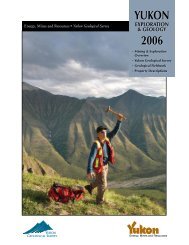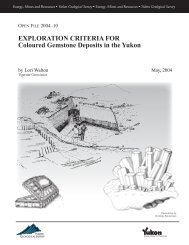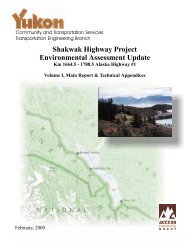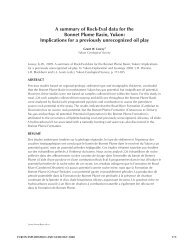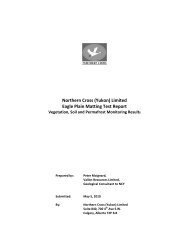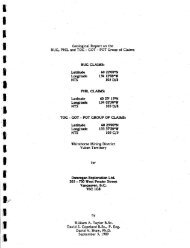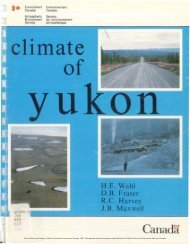WhiteCAP_Plan_01SEPT..
WhiteCAP_Plan_01SEPT..
WhiteCAP_Plan_01SEPT..
You also want an ePaper? Increase the reach of your titles
YUMPU automatically turns print PDFs into web optimized ePapers that Google loves.
NCE <strong>WhiteCAP</strong> Environmental History<br />
The primary natural source of fire ignition is lightning, which often ignites fires during<br />
warm periods when temperatures may exceed 35°C for many consecutive days.<br />
Therefore, hot weather combined with a dry season create a high potential for fire. Such<br />
conditions were present in the summer of 1948 when lightening sparked a local forest<br />
fire. Fires ignited by lightening strikes are reported annually and generally result in more<br />
intense fires (YourYukon, column 233, series 1, June 29, 2001, Sarah Locke).<br />
3.1.2 Impacts of Forest Fires<br />
Forest fire activity may have several consequences. In addition to the physical damage,<br />
the related financial costs can have detrimental effects on the community. For example,<br />
fire control budgets include the cost of personnel salaries, equipment maintenance,<br />
aircraft, and supplies and are based on an annual estimate of fire activity. Thus a high<br />
number of forest fires could require the hiring of additional fire fighters and the<br />
acquisition of additional equipment. Fire can also devastate vulnerable infrastructure<br />
such as roads, power lines and phone lines, adding to the total cost of the fire and<br />
leaving residents without communication and power. For example, the city’s fire budget<br />
became strained in 1984, when a severe forest fire resulted in over-exertion of the fire<br />
crew and the need for additional equipment. Four WWII A-26 tankers were used to drop<br />
fire retardants, while two bird dog aircraft, two patrol planes, a DC-3 (used by smoke<br />
jumpers), 100 employees, and mountain lookouts were ultimately needed to control the<br />
fire. The effort cost approximately $4.6M ($8,600,651.47 in 2009) 5 , exceeding the fire<br />
budget for that year (Whitehorse Star, May 24 th 1984). The city ultimately tried to recover<br />
some of the cost of fighting the fire on Crown/Commissioners land from the federal and<br />
territorial governments.<br />
In addition to the area burned, high winds conditions can create problems by spreading<br />
smoke to new areas. In 1998, the smoke from a nearby 3000 ha forest fire (about 1km<br />
away from Logan subdivision) drifted over Whitehorse and the surrounding area creating<br />
poor air quality for the residents.<br />
Local infrastructure can exacerbate local vulnerability; gravel roads that are irregularly<br />
maintained can be especially problematic, creating difficult or even insurmountable<br />
problems for fire crews trying to access hinterland areas. In May 1974, a private house<br />
burned down because it was located in a slough area that the fire truck could not reach.<br />
Residences located long distances from a fire hall increase response times for fire<br />
fighters.<br />
Forest fire is a natural process of regeneration and can be a benefit to wildlife.<br />
Generally, only small animals such as mice and voles perish in local forest fires. Large<br />
animals such as moose and bear can simply evacuate threatened regions. For example,<br />
a group of marten escaped the 1991 Haeckel Hill fire unscathed. Snowshoe hare<br />
populations generally increase in areas that have recently recovered from forest fires.<br />
This benefits lynx, coyotes and avian predators such as goshawks and great horned<br />
owls. Recently burned areas can provide improved growing conditions for certain plant<br />
species. For example, morel mushrooms grow in large quantities in the moist<br />
5 All values have been adjusted for inflation to their value in 2009 using the Bank of Canada<br />
inflation calculator [online February 2010] http://www.bankofcanada.ca/en/inflation_calc.html<br />
D.3



